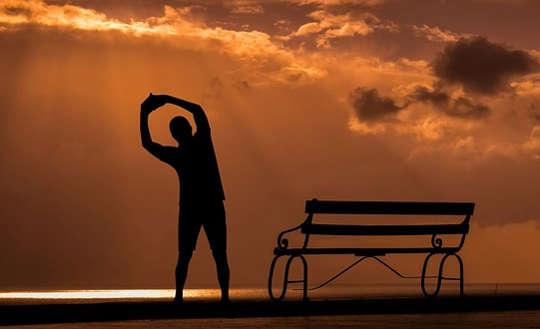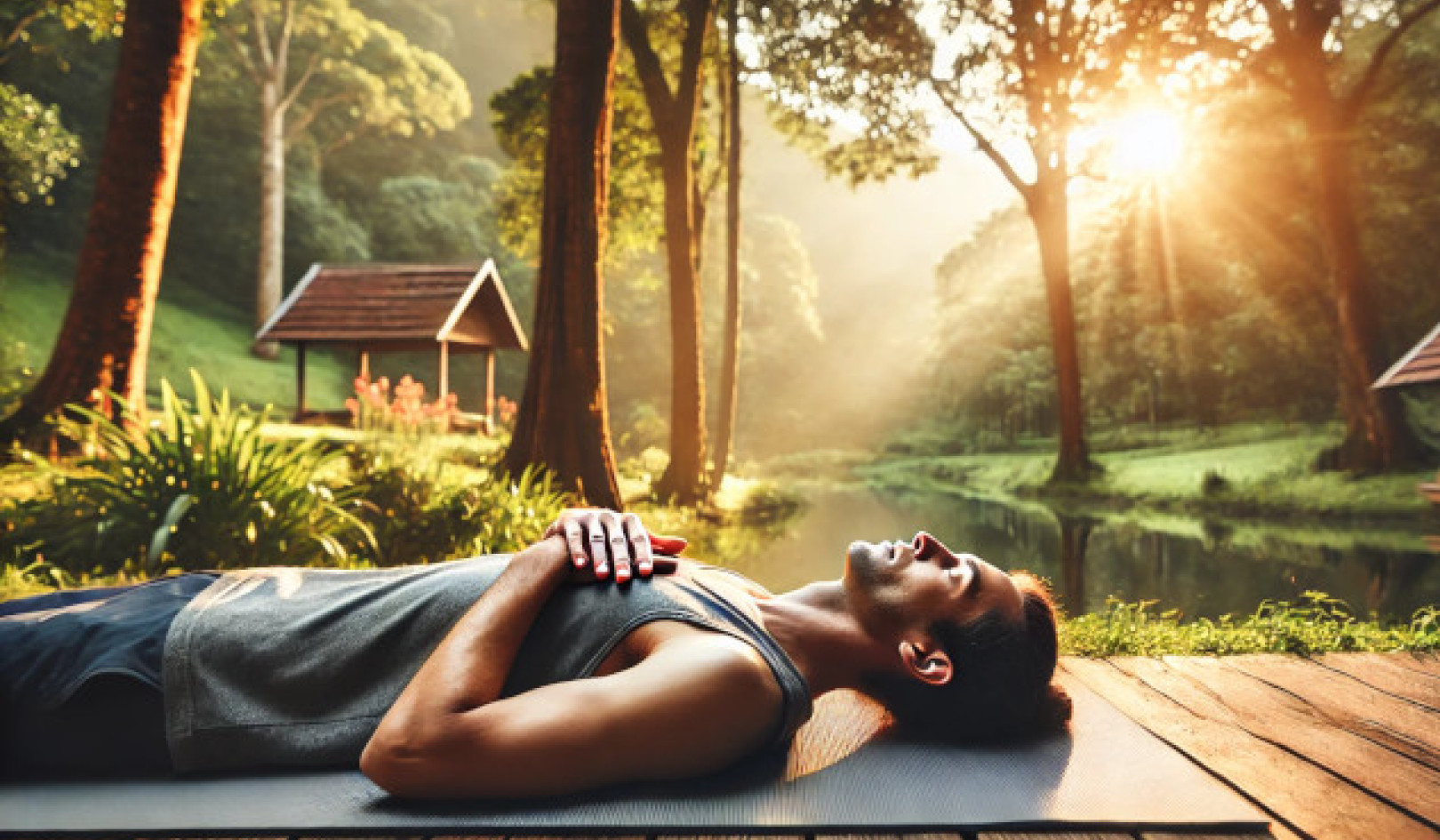
Image by mohamed Hassan
(Editor's Note: While this article is written for men, the principles apply to both men and women.)
In general, men are less flexible than women, a situation that sets us up for a variety of problems when we age -- from the old-man shuffle (the result of too-tight hip flexor muscles) to low back pain and other irritating body aches. That's why we stand to gain so much by adding stretching to our routines. (By the way, one of the best flexibility workouts available is yoga.)
Much of our "inflexibility" may be in our "heads," or maybe in our genetic makeup, a relic of the fight or flight response in which we men tend to hold tension in our hips, gluteal muscles, and hamstrings (the big muscles at the backs of our legs) as if poised to spring away at any moment. When our body is in that forward leaning position, it makes our back work harder than it has to, especially if we're carrying a load or performing exercises (like squats) that place a load on our spine. The result: low back pain and other back problems.
Stretching to Overcome "Inflexibility"
Stretching can help you overcome this inherent tendency, but most people -- men especially -- tend to skimp on this facet of their workouts. By committing to a flexibility routine, however, you can actually prevent injuries that can sideline you in later years and instead continue to use your body more fully, because you'll maintain greater range of motion in your muscles and joints.
That's why stretching is now routine for all athletes -- and should be a routine for all of us. Most mainstream coaches and athletic trainers teach stretches that are derived from yoga poses, whether the athletes realize it or not. Some trainers offer a flexibility assessment, which can help determine which parts of your body need particular attention. Often, they are areas that suffered some previous injury or repeated insult -- the torn rotator cuff from a ski trip several years back, the football injury from college, the stiff back from too many hours of staring at a computer screen.
Systematic and Safe Stretching Exercises
The best trainers will help you stretch out by pushing your limbs farther than you could take them yourself, though it's not a good idea to let an untrained person do this for you, because it could result in injury. I personally have found using a stretching machine very helpful in doing systematic and safe stretching; I ordered a machine for under $500 that I saw advertised in a magazine and it has worked well for me.
There are literally hundreds of stretching exercises. The best program will incorporate stretches for all of your main muscle groups. We've listed a number of good options on the next pages. Whichever you use, here are some things to keep in mind.
- Don't stretch when you're cold. Many people hurt themselves by launching into a vigorous stretch without warming up first. A cold muscle doesn't have a lot of give and if you try to force it, you may end up straining a muscle or tearing a ligament instead. (That's why yoga studios are usually kept at 80 degrees Fahrenheit or warmer.) Before you stretch, walk or jog slowly for a few minutes to get your body warm and the blood flowing to your muscles.
- Breathe like you mean it. Americans tend to break every activity into its component parts, so they'll stretch but not breathe. But breath control is an integral part of stretching (and yoga) because it helps you work your muscles more effectively. While you're stretching, make sure you continue to breathe deeply throughout the stretch. The resultant calm helps you relax all over and get more from each move.
- Take it easy. Flexibility is relative and changes from day to day and hour to hour. You want to stretch muscle, not ligaments, and you have to do so slowly. (Yogis talk about "embracing the bone," by which they mean contracting the muscle, becoming aware of its whole length before trying to elongate it.) Eventually, with regular stretching, your muscles will stay looser and more flexible. But you can overstretch, too, which makes ligaments about as useful as a stretched out elastic band. There are plenty of karate black belts who were once proud of the splits they could do and are now hobbling around like old men.
- Don't even think about competing. On a recent television sit-com, a pair of male characters talked about attending yoga class together. One pointed a finger at the other, and in an aggressive voice blurted out, "I'll kick your ass in yoga!" It was a comic moment, but like most such moments bore a lot of truth. Men tend to look for the end goal, thinking about reaching the floor with their fingertips rather than about how tight their legs and back are as they reach. Stretching is not a competitive event, and if you try to make it one, chances are you'll injure yourself.
- Let yourself relax. Stretching is the yin to the strength-training yang. Instead of pushing yourself into a stretch, allow yourself to relax into it, going only as far as your body can comfortably go. (Don't ever bounce or do ballistic stretches.) Then breathe. You'll be amazed at how rejuvenated you feel when you're done.
- Hold each stretch 20 to 30 seconds. By staying in a stretch for that long, you give your muscles time to respond and lengthen. Any shorter time and you may be wasting your time.
10 Stretches To Keep You Limber
Here are 10 stretches that will help keep you limber throughout your life. Since I have introduced stretching into my exercise routine, I have noticed much more flexibility in my body for everyday activities such as turning my neck to check oncoming traffic at an intersection. I actually use a stretching machine used by many golfers and advertised in golfing magazines. I find the machine routine, which I do in about 5 minutes after my usual 25 minutes on my cross-country machine, is a very easy and organized way to stretch all my major muscle groups. However, you can accomplish the same goal with simple exercises, such as the following.
These stretches focus on the body parts where men hold the most tension -- the hips, back and hamstrings. Remember to warm up before your stretch, and be careful not to push your muscles too far.
1. Shoulder Stretch. Hold a belt or necktie above your head with your elbows straight and your hands about shoulder-width apart. Keep your wrists straightened and pull gently without gripping so tightly that your knuckles turn white. Hold far at least 10 seconds (that's how long muscles need to stretch with any significance). Hold it for 30 seconds to a minute if you want even more flexibility; improvements tend to diminish after that. Then, widen your grip on the belt and, while maintaining the pull, allow one hand to drop slowly behind you to about waist height. Raise both hands and allow the other hand to drop behind you, to about waist height. Finally, lower both hands behind you and hold the stretch. You should feel your shoulder blades opening.
2. Hamstring and Back Stretch. Lie with your back flat on the floor and your legs up against a wall. You may not be able to straighten your legs completely. Just straighten them until you feel a gentle stretch in your back and hamstrings. This is a more passive stretch than the hamstring stretch with the belt that follows -- and a great starter hamstring stretch. To deepen the stretch, lie inside an open doorway, with your leg up on the wall. To increase the stretch, scoot yourself further out the door, toward your feet, as you leave your leg up against the wall. Easy does it, though.
3. Hamstring Stretch with Belt. While lying on your back, keep your right leg straight on the floor and hug your left knee to your chest. Loop a belt around your left foot at the base of your toes. Straighten your left leg and pull on the belt so the foot comes over your chest or head. (If your lower back tightens and arches as you raise your left leg, bend your right knee and rest the right foot on the floor.) This is one of the best hamstring stretches you can do -- better than the ones you do while standing. To add an inner thigh stretch, keep pulling on the belt while letting your left leg drift open to the outside. Then switch hands and lower the leg toward the inside to stretch the outer hip. Don't touch the foot to the floor; the point is not to reach all the way to the ground (which would lift the other leg off the ground) but to savor the stretches and increase your ability to balance in your torso.
While stretching, try to breathe into your abdomen so you feel your back expanding and contracting with each breath. You should feel the effects in your hips and back, quads and psoas (in the front of the hip), as well as in your hamstrings. Repeat on the other side.
4. Calf Stretch. Facing a step, with your right foot firmly on the step, arrange your left foot so that the front half of the foot is on the edge of the step, with the back half hanging off the edge. Once you're balanced, let the left heel drop so that you feel the stretch in the back of your left leg. Don't bounce -- just maintain the stretch for 10 to 30 seconds. Then switch and stretch the right leg.
5. Spine Stretch. Lie flat on your back with your legs straight, toes pointed, and arms stretched overhead, palms together. Gently rock your arms up and down in a short 8- to 12-inch arc. You'll feel your spine stretching between the shoulder blades.
6. Downward Facing Dog. Starting on your hands and knees, raise your butt so that your body forms an upside-down Y. Try to straighten your spine so that your lower back is not rounded. If you have tight ham strings, you probably won't be able to put your heels on the floor right away. To build flexibility at a sensible pace in this position, bend one knee and straighten the other leg, easing the heel toward the ground. Hold for 10 seconds and alternate. Let the weight of your upper body rest at the base of your fingers, not the palm of your hands. Yogis call this "downward facing dog."
7. Achilles Stretch. Bend one knee and step back with the other leg to get into a lunge position, with your front foot between your hands and your back leg slightly bent or straight and perpendicular to the floor. Relax the back hip. Lower your shoulder toward the ground if you'd like to add a deeper stretch for the groin. Repeat on the other side.
8. Inner Thigh Stretch. Sit up straight on the floor and place the soles of your feet together in front of you. Wrap your hands around your ankles and gently push down on your thighs with your elbows. Avoid tensing your upper body to do this. Let gravity and the weight of your elbows open your thighs.
9. Hip and Back Stretch. Sit comfortably cross-legged on the floor with your right leg on top of your left. Lean your upper body forward and walk your arms out in front of you. If you have enough flexibility, place both elbows on the floor. Lean forward until you feel a gentle stretch in the hips and back, then stop. Reverse your legs, placing the left leg on top, and repeat
10. Twister Stretch. Sit on the floor with your right leg in front of you and your left leg bent, left foot flat on the floor on the outside of your right knee. Place your left hand behind you and twist at your waist away from your knee. If you can, place your right arm on the outside of your left knee. Repeat on the other side.
©2002. Reprinted with permission of the publisher,
Hyperion. http://www.hyperionbooks.com
Article Source
Dr. Timothy Johnson's On Call Guide To Men's Health,
by Dr. Timothy Johnson.
 From Dr. Timothy Johnson, respected health authority and medical correspondent for ABC News, comes a comprehensive, accessible guide to men's wellness that no man should be without. Drawing on cutting-edge medical techniques, leading medical experts, and first-hand accounts, he provides men of all ages with guidelines for staying healthy, for developing good relationships with their doctors, and for dealing effectively with medical concerns as they arise.
From Dr. Timothy Johnson, respected health authority and medical correspondent for ABC News, comes a comprehensive, accessible guide to men's wellness that no man should be without. Drawing on cutting-edge medical techniques, leading medical experts, and first-hand accounts, he provides men of all ages with guidelines for staying healthy, for developing good relationships with their doctors, and for dealing effectively with medical concerns as they arise.
Info/Order this book
Related Books
About the Author

Dr. Timothy Johnson is the medical editor for ABC News and appears regularly on World News Tonight, Nightline, Good Morning America, and 20/20. He holds joint positions in medicine at Harvard University and Massachusetts General Hospital in Boston, and is the founding editor of the Harvard Medical School Health Letter and coeditor of the Harvard Medical School Health Letter Book.
Additional Info
The following has been added to the original article for your information

























